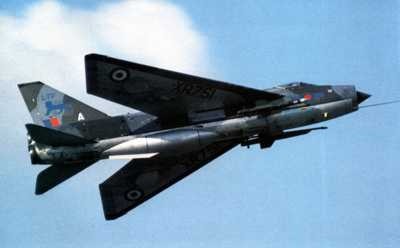
The Lightning was the end result of a
supersonic research programme carried out by English Electric. The first
aircraft, the P.1A, first flew in August 1954. A modified version intended
to be the basis for an all weather interceptor, the P.1B, was first flown
in April 1957. Three of these prototypes were built. During November 1958
the aircraft exceeded Mach 2 for the first time and also received the name
Lightning. To facilitate further testing and to gain experience of
supersonic aircraft the RAF ordered 20 pre-production aircraft.
Production aircraft were given the F.1 designation, the first F.1 aircraft
flew in October 1959. Later additions such as the provision for in-flight
refuelling and new radio changed the F.1 to an F.1A designation.
The F.2, when it first appeared in 1961, added enhanced performance,
nosewheel steering, variable after burners, enhanced electronics and a
modified fin.
The next variant was the F.3 which had 300 series Avon engines and the
addition of the Red Top missile, plus the enhanced AI23B radar. With the
F.3A came a new wing, kinked and cambered, addition fuel capacity with
enlarged ventral tanks.
The F.6 was almost the same as the F.3A, new aircraft were built to this
standard. Export versions to Kuwait and Saudi Arabia were modified
versions of the F.6 given the designation F.53.
To enable pilots to be trained on this high performance aircraft two seat
training versions were built. The T.4 was a two seat variant based upon
the F.1. Later training Lightnings, T.5s and T.55s were based upon the
F.3, the T.55 being the export version of the T.5
Lightnings were designed as pure
interceptors. Later modifications added more roles. It was as an
interceptor that the RAF operated the Lightning. In the UK it provided
fighter cover for the UK during the dark years of the cold war. Many
intercepts of Russian reconnaissance and bomber aircraft being made over
the North Sea on a daily basis. The Lightning pilots would be sitting in
the aircraft in their QRA shelters waiting for the scramble.
Specifications
(F.6):
Engines: Two 13,200-pound thrust
Rolls-Royce RA34R afterburning Avon 310 turbojets
Weight: Empty 28,000 lbs., Max Takeoff 50,000 lbs.
Wing Span: 34ft. 10in.
Length: 55ft. 3in.
Height: 19ft. 7in.
Performance:
Maximum Speed at 40,000 ft: 1,500 mph (Mach 2.3)
Ceiling: 60,000 ft.
Range: 800 miles
Armament:
* Two 30-mm Aden guns in ventral pack
* Two Firestreak or Red Top air-to-air missiles, or
44 50.4-mm (2-inch) rockets, or
Five Vinteen 360 70-mm cameras and linescan equipment and
underwing flares
* Up to 144 rockets or six 1,000-pound bombs on underwing/overwing
hardpoints
Number
Built: 339
Number
Still Airworthy: Two
